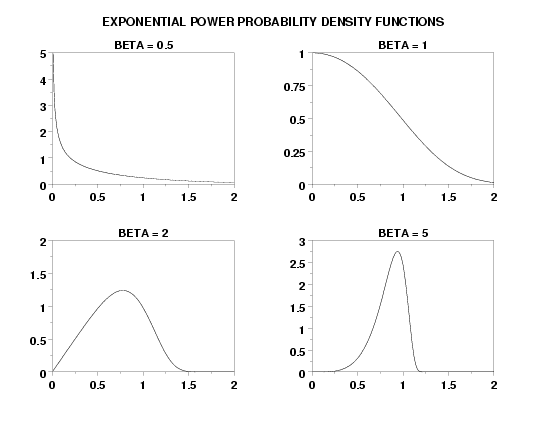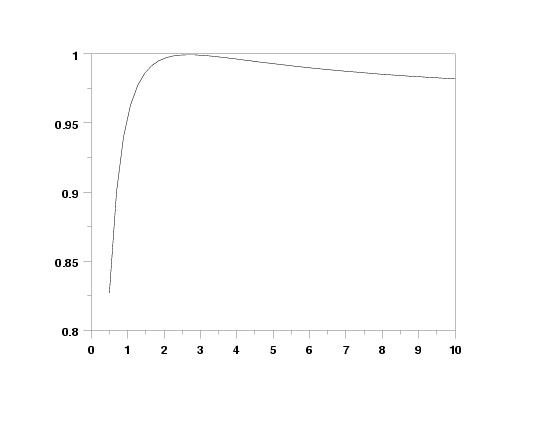

|
PEXPDFName:
 . .

with This distribution can be generalized with location and scale parameters using the relation

This distribution was proposed by Dhillon as useful distribution for reliability applications since it can have increasing, decreasing, or bathtub shaped hazard functions.
<SUBSET/EXCEPT/FOR qualification> where <x> is a number, parameter, or variable containing positive values; <y> is a variable or a parameter (depending on what <x> is) where the computed exponential power pdf value is stored; <beta> is a positive number, parameter, or variable that specifies the shape parameter; <loc> is a number, parameter, or variable that specifies the location parameter; <scale> is a positive number, parameter, or variable that specifies the scale parameter; and where the <SUBSET/EXCEPT/FOR qualification> is optional. If <loc> and <scale> are omitted, they default to 0 and 1, respectively.
LET A = PEXPDF(X1,2.5,0,10) PLOT PEXPDF(X,2.5,0,3) FOR X = 0.1 0.1 10
to
This was done since ALPHA is in fact a scale parameter (in the articles listed in the References section, ALPHA is actually the reciprocal of the scale parameter).
LET Y = EXPONENTIAL POWER RANDOM NUMBERS FOR I = 1 1 N EXPONENTIAL POWER PROBABILITY PLOT Y EXPONENTIAL POWER PROBABILITY PLOT Y2 X2 EXPONENTIAL POWER PROBABILITY PLOT Y3 XLOW XHIGH EXPONENTIAL POWER KOLMOGOROV SMIRNOV ... GOODNESS OF FIT Y EXPONENTIAL POWER CHI-SQUARE GOODNESS OF FIT ... Y2 X2 EXPONENTIAL POWER CHI-SQUARE GOODNESS OF FIT ... Y3 XLOW XHIGH The following commands can be used to estimate the beta shape parameter for the exponential power distribution:
LET BETA2 = <value> EXPONENTIAL POWER PPCC PLOT Y EXPONENTIAL POWER PPCC PLOT Y2 X2 EXPONENTIAL POWER PPCC PLOT Y3 XLOW XHIGH EXPONENTIAL POWER KS PLOT Y EXPONENTIAL POWER KS PLOT Y2 X2 EXPONENTIAL POWER KS PLOT Y3 XLOW XHIGH The default values for BETA1 and BETA2 are 0.5 and 10. The probability plot can then be used to estimate the location and scale (location = PPA0, scale = PPA1). The 2-parameter exponential power maximum likelihood estimates can be obtained using the command
The maximum likelihood estimates are the solution of the following simultaneous equations:
![(n/beta) + n*LOG(alpha) + SUM[i=1 to n][A(i)] -
SUM[i=1 to n][B(i)*C(i)*EXP(B(i))] + SUM[i=1 to n][B(i)*C(i)] = 0](eqns/pexmle1.gif)
where
 = 1/scale
= 1/scale
The standard error of
![-(n/beta^2) - SUM[i=1 to n][C(i)^2*B(i)*(B(i)+1)*EXP(B(i))] +
SUM[i=1 to n][C(i)^2*B(i)]](eqns/betase.gif)
The standard error of
![-(beta*n/alpha^2) -
(beta/alpha^2)*SUM[i=1 to n][EXP(B(i))*((beta-1)*B(i) + B(i)^2*beta)] +
(beta*(beta-1)/alpha^2)*SUM[i=1 to n][B(i)]](eqns/alphase.gif)
The covariance of
![(n/alpha) -
(1/alpha)*SUM[i=1 to n][B(i)*EXP(B(i))*(1+beta*LOG(alpha)+beta*A(i)+
beta*B(i)*C(i)} +
(1/alpha)*SUM[i=1 to n][B(i)*(1+beta*LOG(alpha)+beta*A(i))}](eqns/covse.gif)
The above equations are from the Dhillon paper. Our experience indicates that the maximum likelihood can fail, particularly when the scale parameter is > 1. Specifying improved starting values can sometimes help (for example, use the estimates obtained from the ppcc/ probability plot method as starting values). These can be specified with the commands
LET BETASV = <value> In this context, ALPHASV is the starting value for the scale parameter, not the reciprocal of the scale parameter. The BOOTSTRAP DISTRIBUTION command can be used to find uncertainty intervals for the ppcc plot and the ks plot methods. Bootstrap confidence intervals are currently not supported for the maximum likelihood method.
Dhillon (1981), "Life Distributions", IEEE Transactions on Reliability, Vol. R-30, No. 5, pp. 457-459.
2007/11: Corrected the second shape parameter to be the scale parameter
LABEL CASE ASIS
TITLE CASE ASIS
TITLE OFFSET 2
.
MULTIPLOT 2 2
MULTIPLOT CORNER COORDINATES 0 0 100 95
MULTIPLOT SCALE FACTOR 2
.
LET BETA = 0.5
TITLE BETA = ^beta
PLOT PEXPDF(X,BETA) FOR X = 0.01 0.01 2
.
LET BETA = 1
TITLE BETA = ^beta
PLOT PEXPDF(X,BETA) FOR X = 0.01 0.01 2
.
LET BETA = 2
TITLE BETA = ^beta
PLOT PEXPDF(X,BETA) FOR X = 0.01 0.01 2
.
LET BETA = 5
TITLE BETA = ^beta
PLOT PEXPDF(X,BETA) FOR X = 0.01 0.01 2
.
END OF MULTIPLOT
.
JUSTIFICATION CENTER
MOVE 50 97
TEXT Exponential Power Probability Density Functions
 Program 2:
Program 2:
let beta = 2.4
let y = exponential power random numbers for i = 1 1 200
let y = 0.6*y
let betasav = beta
let amax = maximum y
.
exponential power ppcc plot y
let beta1 = beta - 1
let beta1 = max(beta1,0.1)
let beta2 = beta + 1
y1label Correlation Coefficient
x1label Beta
exponential power ppcc plot y
justification center
move 50 6
let beta = shape
text Betahat = ^beta (True Value: ^betasav)
.
char x
line bl
y1label Data
x1label Theoretical
exponential power prob plot y
move 50 6
text Location = ^ppa0, Scale = ^ppa1
move 50 2
text PPCC = ^ppcc
char bl
line so
label
.
relative histogram y
limits freeze
pre-erase off
plot pexpdf(x,beta,ppa0,ppa1) for x = 0.01 .01 amax
limits
pre-erase on
.
let ksloc = ppa0
let ksscale = ppa1
exponential power kolm smir goodness of fit y
.
exponential power mle y
.
let beta = betaml
let ksloc = ppa0
let ksscale = alphaml
exponential power kolm smir goodness of fit y

Date created: 11/27/2007 |